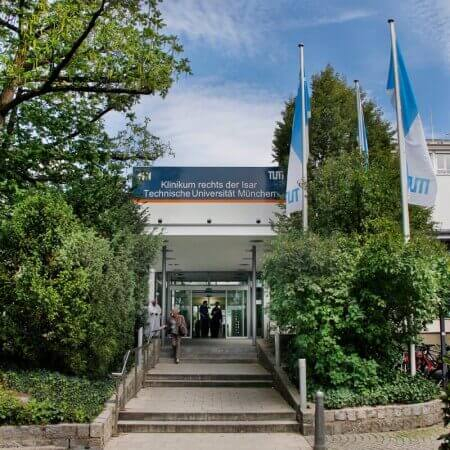Uterine fibroids are benign neoplasms that commonly cause infertility, miscarriage, and uterine bleeding. Myomas may also cause heavy and prolonged monthlies, as well as abnormal uterine bleeding between monthlies. You can undergo your diagnostics and treatment abroad to restore your reproductive function or get rid of the symptoms of the disease. You are welcome to use the Booking Health service to check prices and compare the cost of treatment at different hospitals.
Content
- Diagnostics
- Treatment principles
- Myoma surgery
- Minimally invasive treatment
- Why to undergo your treatment abroad?
Diagnostics
Patients seek medical attention with complaints of pelvic pain, bleeding, and difficulty conceiving. Myomas may sometimes be detected incidentally, as many women have no symptoms.
The diagnosis can be confirmed with ultrasound diagnostics. This is the main examination that allows for the determination of the location and size of the uterine fibroids, as well as the features of their blood supply. An MRI scan is rarely required for diagnostics. A contrast-enhanced examination distinguishes between a myoma and a malignant tumor, specifically a leiomyosarcoma.
Treatment principles
Uterine fibroids can be treated with medications, surgery, or minimally invasive procedures. The goal of the intervention is not necessarily total removal of the tumor, as its shrinkage is enough to eliminate the symptoms.
The only option for a complete cure for the disease is the removal of the uterus. In this case, you can expect not only the elimination of all myomatous nodes but also a zero risk of their repeated future growth. However, this treatment option is unacceptable for most women of reproductive age, so organ-preserving operations are preferred.
The treatment of uterine fibroids abroad includes the following:
- surgical removal of myomatous nodes;
- destruction of myomas with various energies (laser, radiofrequency ablation, or ultrasound);
- blood supply blockage to uterine fibroids, which leads to the death of their tissues.
Doctors in developed countries offer the latest methods of treatment for the disease. These are minimally traumatic, have a low risk of complications, and have a short rehabilitation period. Some procedures do not even require a hospital stay.
Myoma surgery
The following two types of operations can be performed for uterine fibroids:
- a hysterectomy, which is a surgical procedure for uterine removal;
- a myomectomy, which is a surgical procedure for myomatous node removal.
A hysterectomy can be performed with the use of a vaginal approach, a laparotomy (through a large abdominal incision), or a laparoscopy (through several small abdominal incisions). Surgeons in developed countries almost never use laparotomy because it is too traumatic. They therefore apply more sparing interventions through a vaginal or laparoscopic approach.
A myomectomy is the method of choice for women who wish to maintain or restore their reproductive function. This is a complex operation if a woman has many large nodes that are not located on the pedicle. The operation should be performed by doctors who have vast experience in uterine reconstruction. A well-performed surgical procedure means not only the possibility of getting pregnant but also a low risk of uterine rupture as well as a good chance of having a baby through the natural birth canal without a C-section.
A myomectomy may involve the use of different surgical approaches, depending on the location of the node. If the nodes are located mainly in the uterine cavity, a hysteroscopy (an endoscopic operation from inside the uterus) will be used. This is the least traumatic treatment option. Women recover in one week after such operations. When myomas are mainly located in the uterine wall and abdominal cavity, a laparoscopic approach is preferable. The recovery period after such operations is about two weeks. In countries with a poor level of medicine, the main type of surgical approach is considered to be a laparotomy, which means that the operation will be performed through a large abdominal incision. Such operations are also effective, but the recovery time reaches 8 weeks, the risk of complications is much higher, the blood loss is greater, and there is a threat of tubal-peritoneal infertility due to the formation of a large number of adhesions in the abdominal cavity.
Minimally invasive treatment
Minimally invasive procedures for uterine fibroids are most commonly used in women who do not intend to have children. All of them are aimed at the destruction of tumor tissue or the impairment of blood supply in the myomatous node, after which it decreases in size due to ischemic necrosis (death due to a lack of blood supply).
The following treatment methods are used in developed countries:
Uterine artery embolization is the most common minimally invasive procedure performed from inside the blood vessels. A small incision in the groin where the femoral artery passes is sufficient to access the arteries. The manipulation is performed under X-ray guidance. Doctors block the blood vessels that supply myomas. As a result, the size of the neoplasms rapidly decreases because the cells die as they do not receive any oxygen and nutrients. Embolization is considered the best treatment for intramural fibroids. Less commonly, it can be used for submucosal fibroids, but in this case, a hysteroscopy is considered the preferred method. Embolization is not suitable for treating pedunculated myomas larger than 8 cm.
Myolysis is the procedure for the destruction of uterine fibroids with various energies, such as laser, bipolar coagulation, radiofrequency ablation, or cryomyolysis (freezing). This is a minor surgery that is performed using a laparoscopic approach. The technique is optimally suited for the treatment of fibroids, which are located mainly in the abdominal cavity. Small tumors in the wall of the organ are not always detected during laparoscopy, so doctors use intraoperative imaging techniques to detect and destroy all tumors. A pregnancy after this procedure is undesirable due to the high risk of complications. Many women develop infertility. However, it is a good treatment option for patients who do not have any reproductive plans.
MRI-guided interstitial coagulation is an innovative technique that has not yet been widely adopted. It is essentially a method similar to myolysis, as doctors use a laser or radiofrequency ablation to destroy the nodes. However, approaching them no longer necessitates a laparoscopy. The procedure is performed through abdominal punctures. The probes are inserted and positioned under the guidance of intraoperative diagnostics.
Magnetic resonance-guided focused ultrasound (MRgFUS) is another alternative to myolysis, which has advantages in terms of its safety and efficiency. This is a completely non-invasive procedure that does not require any incisions or punctures of the anterior abdominal wall. Ultrasonic waves affect fibroids, penetrating the nodes through the abdominal wall. The procedure is carried out under MRI guidance. It lasts from 2 to 4 hours. Doctors have full control over the process of tumor destruction, therefore, unlike myolysis, excessive or insufficient energy exposure is practically impossible.
Doppler-guided uterine artery occlusion (D-UAO) is a new technique that is not yet considered standard. Doctors use a special vascular clamp to temporarily close the lumen of the uterine arteries. They are located very close to the lateral fornices of the vagina, so the procedure is performed with a transvaginal approach. It is performed on an outpatient basis. The recovery period afterward is 3 days.
Why to undergo your treatment abroad?
If you have uterine fibroids, you can undergo your treatment for this disease at one of the best hospitals in the world. You are welcome to visit the Booking Health website to find out the cost of treatment and compare prices. There are a few reasons for you to undergo your treatment abroad. These are the following:
- organ-preserving treatment is preferred;
- instead of traumatic interventions through a large incision in the anterior abdominal wall, operations are performed through short abdominal incisions or from inside the uterus;
- patients of reproductive age can preserve and restore their fertility;
- the use of innovative methods for the destruction of myomatous nodes without any surgery;
- adequate pain relief, rehabilitation, and high-quality postoperative care.
You are welcome to make an appointment for your treatment abroad through the Booking Health website. The cost of treatment will be lower for you. The price will be reduced for you due to the lack of any taxes for foreign patients. The specialists from the Booking Health company will help you select the best hospital and arrange your trip. Even if additional procedures are required, the initial cost of treatment will not increase after the beginning of your medical care program, as you will receive insurance that will cover all extra medical expenses.
Authors:
The article was edited by medical experts, board-certified doctors Dr. Nadezhda Ivanisova and Dr. Sergey Pashchenko. For the treatment of the conditions referred to in the article, you must consult a doctor; the information in the article is not intended for self-medication!
Sources:
Healthline
Verywell Health
MedicineNet




















